Project: Opportunities and Challenges of E-Commerce in Australia
VerifiedAdded on 2020/05/16
|14
|3039
|121
Project
AI Summary
This project examines the opportunities and challenges within the Australian e-commerce industry. It begins with an introduction to electronic commerce, defining its scope and segmentation into e-merchandise and e-finance. The project's objectives include investigating opportunities, evaluating the intensity of online buying and selling, and assessing growth prospects. A comprehensive literature review explores the growth of e-commerce in Australia, citing statistics and market trends, and identifies key challenges and opportunities. The research methodology involves both qualitative and quantitative approaches, including interviews, surveys, and data analysis. The project outlines research questions, hypotheses, and potential limitations, providing a detailed time schedule. The conclusion summarizes the key findings and implications of the research, offering insights into the future of e-commerce in Australia. The project uses both primary and secondary data to analyze the Australian e-commerce market.
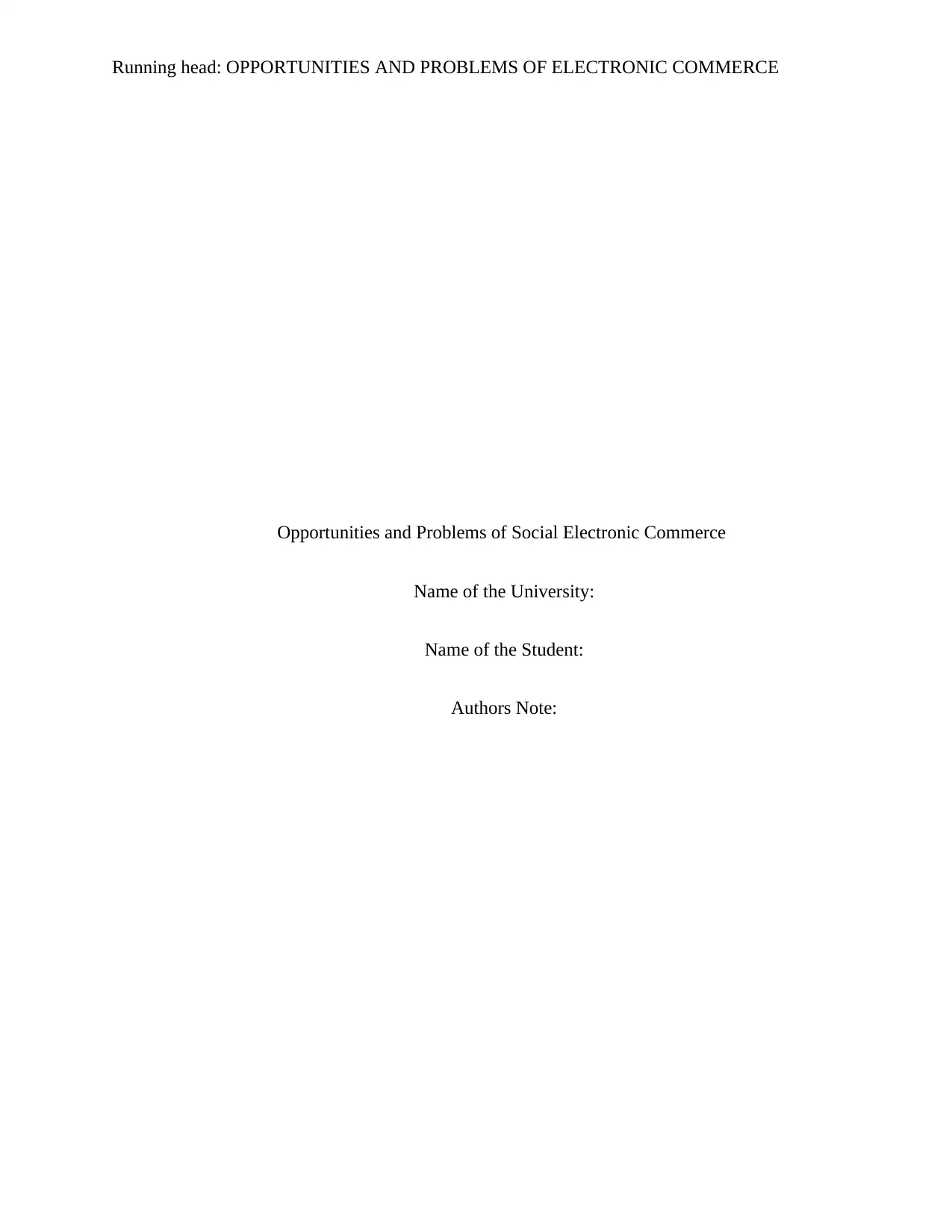
Running head: OPPORTUNITIES AND PROBLEMS OF ELECTRONIC COMMERCE
Opportunities and Problems of Social Electronic Commerce
Name of the University:
Name of the Student:
Authors Note:
Opportunities and Problems of Social Electronic Commerce
Name of the University:
Name of the Student:
Authors Note:
Paraphrase This Document
Need a fresh take? Get an instant paraphrase of this document with our AI Paraphraser
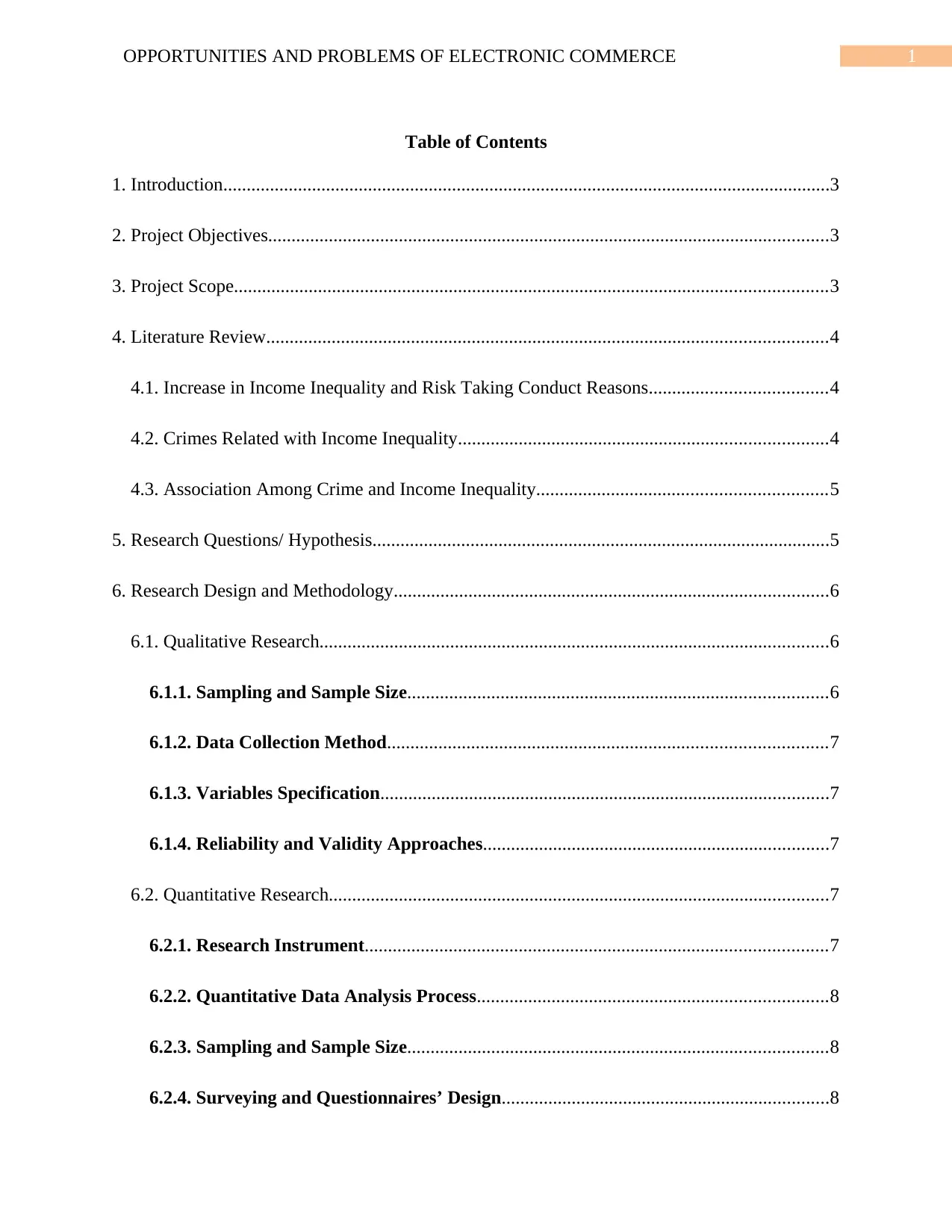
1OPPORTUNITIES AND PROBLEMS OF ELECTRONIC COMMERCE
Table of Contents
1. Introduction..................................................................................................................................3
2. Project Objectives........................................................................................................................3
3. Project Scope...............................................................................................................................3
4. Literature Review........................................................................................................................4
4.1. Increase in Income Inequality and Risk Taking Conduct Reasons......................................4
4.2. Crimes Related with Income Inequality...............................................................................4
4.3. Association Among Crime and Income Inequality..............................................................5
5. Research Questions/ Hypothesis..................................................................................................5
6. Research Design and Methodology.............................................................................................6
6.1. Qualitative Research.............................................................................................................6
6.1.1. Sampling and Sample Size..........................................................................................6
6.1.2. Data Collection Method..............................................................................................7
6.1.3. Variables Specification................................................................................................7
6.1.4. Reliability and Validity Approaches..........................................................................7
6.2. Quantitative Research...........................................................................................................7
6.2.1. Research Instrument...................................................................................................7
6.2.2. Quantitative Data Analysis Process...........................................................................8
6.2.3. Sampling and Sample Size..........................................................................................8
6.2.4. Surveying and Questionnaires’ Design......................................................................8
Table of Contents
1. Introduction..................................................................................................................................3
2. Project Objectives........................................................................................................................3
3. Project Scope...............................................................................................................................3
4. Literature Review........................................................................................................................4
4.1. Increase in Income Inequality and Risk Taking Conduct Reasons......................................4
4.2. Crimes Related with Income Inequality...............................................................................4
4.3. Association Among Crime and Income Inequality..............................................................5
5. Research Questions/ Hypothesis..................................................................................................5
6. Research Design and Methodology.............................................................................................6
6.1. Qualitative Research.............................................................................................................6
6.1.1. Sampling and Sample Size..........................................................................................6
6.1.2. Data Collection Method..............................................................................................7
6.1.3. Variables Specification................................................................................................7
6.1.4. Reliability and Validity Approaches..........................................................................7
6.2. Quantitative Research...........................................................................................................7
6.2.1. Research Instrument...................................................................................................7
6.2.2. Quantitative Data Analysis Process...........................................................................8
6.2.3. Sampling and Sample Size..........................................................................................8
6.2.4. Surveying and Questionnaires’ Design......................................................................8
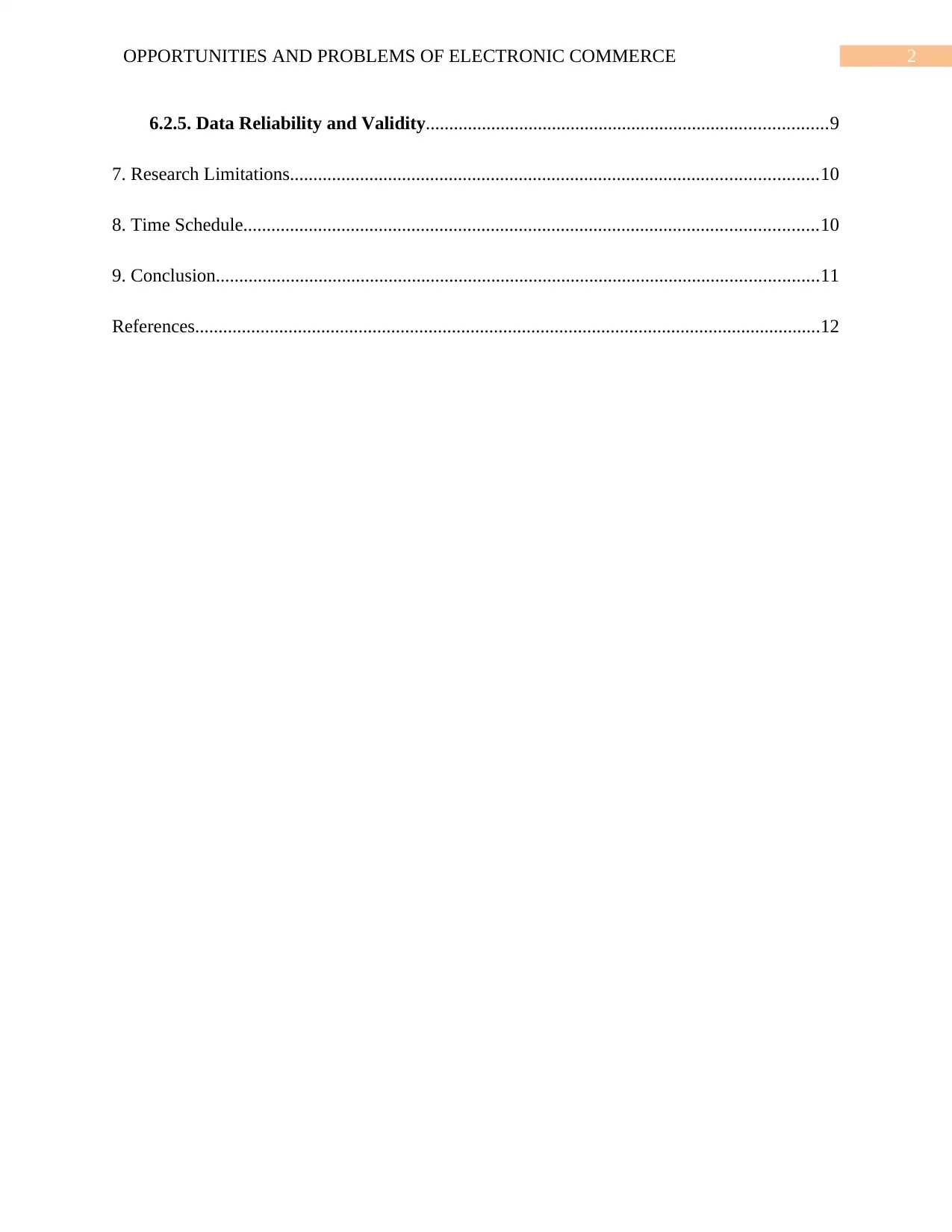
2OPPORTUNITIES AND PROBLEMS OF ELECTRONIC COMMERCE
6.2.5. Data Reliability and Validity......................................................................................9
7. Research Limitations.................................................................................................................10
8. Time Schedule...........................................................................................................................10
9. Conclusion.................................................................................................................................11
References......................................................................................................................................12
6.2.5. Data Reliability and Validity......................................................................................9
7. Research Limitations.................................................................................................................10
8. Time Schedule...........................................................................................................................10
9. Conclusion.................................................................................................................................11
References......................................................................................................................................12
⊘ This is a preview!⊘
Do you want full access?
Subscribe today to unlock all pages.

Trusted by 1+ million students worldwide
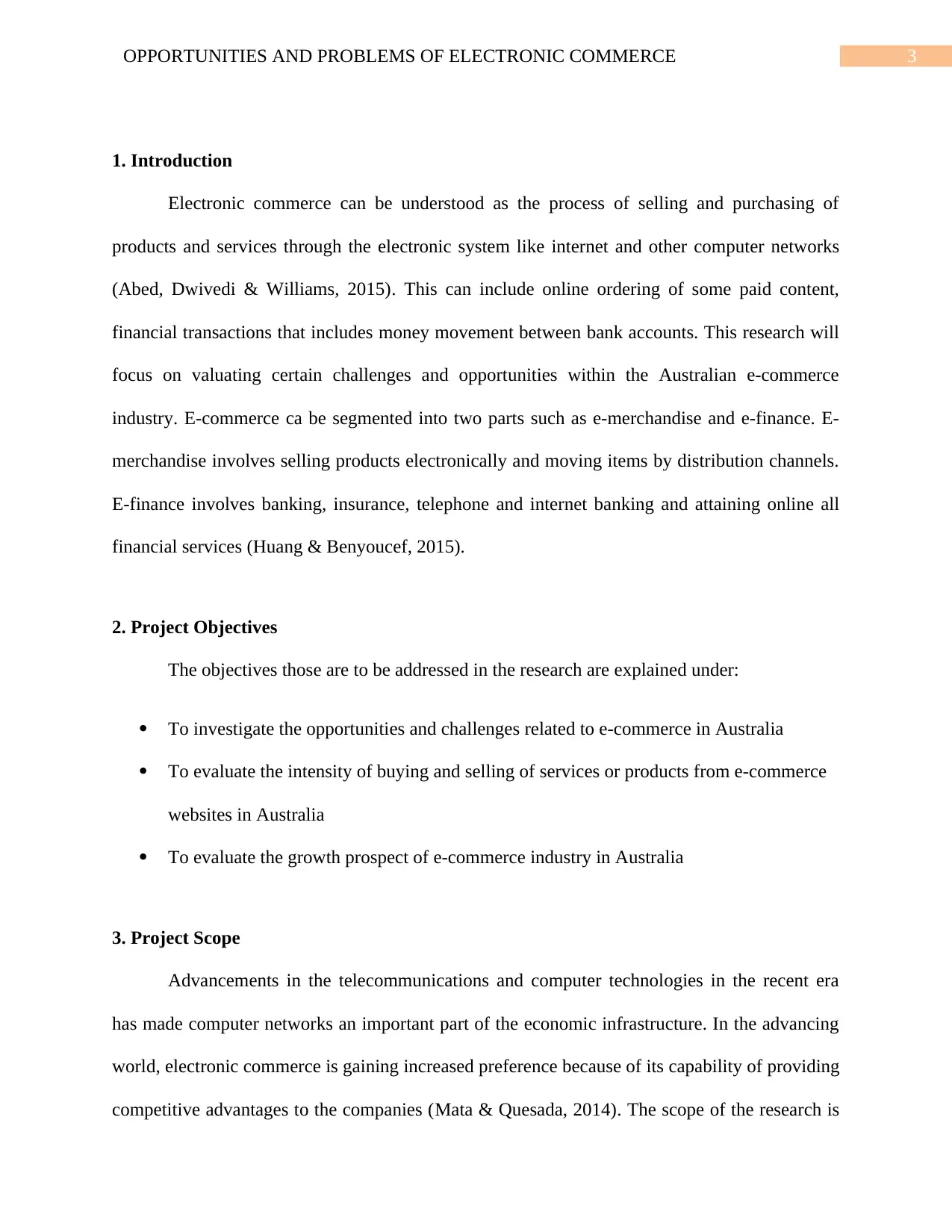
3OPPORTUNITIES AND PROBLEMS OF ELECTRONIC COMMERCE
1. Introduction
Electronic commerce can be understood as the process of selling and purchasing of
products and services through the electronic system like internet and other computer networks
(Abed, Dwivedi & Williams, 2015). This can include online ordering of some paid content,
financial transactions that includes money movement between bank accounts. This research will
focus on valuating certain challenges and opportunities within the Australian e-commerce
industry. E-commerce ca be segmented into two parts such as e-merchandise and e-finance. E-
merchandise involves selling products electronically and moving items by distribution channels.
E-finance involves banking, insurance, telephone and internet banking and attaining online all
financial services (Huang & Benyoucef, 2015).
2. Project Objectives
The objectives those are to be addressed in the research are explained under:
To investigate the opportunities and challenges related to e-commerce in Australia
To evaluate the intensity of buying and selling of services or products from e-commerce
websites in Australia
To evaluate the growth prospect of e-commerce industry in Australia
3. Project Scope
Advancements in the telecommunications and computer technologies in the recent era
has made computer networks an important part of the economic infrastructure. In the advancing
world, electronic commerce is gaining increased preference because of its capability of providing
competitive advantages to the companies (Mata & Quesada, 2014). The scope of the research is
1. Introduction
Electronic commerce can be understood as the process of selling and purchasing of
products and services through the electronic system like internet and other computer networks
(Abed, Dwivedi & Williams, 2015). This can include online ordering of some paid content,
financial transactions that includes money movement between bank accounts. This research will
focus on valuating certain challenges and opportunities within the Australian e-commerce
industry. E-commerce ca be segmented into two parts such as e-merchandise and e-finance. E-
merchandise involves selling products electronically and moving items by distribution channels.
E-finance involves banking, insurance, telephone and internet banking and attaining online all
financial services (Huang & Benyoucef, 2015).
2. Project Objectives
The objectives those are to be addressed in the research are explained under:
To investigate the opportunities and challenges related to e-commerce in Australia
To evaluate the intensity of buying and selling of services or products from e-commerce
websites in Australia
To evaluate the growth prospect of e-commerce industry in Australia
3. Project Scope
Advancements in the telecommunications and computer technologies in the recent era
has made computer networks an important part of the economic infrastructure. In the advancing
world, electronic commerce is gaining increased preference because of its capability of providing
competitive advantages to the companies (Mata & Quesada, 2014). The scope of the research is
Paraphrase This Document
Need a fresh take? Get an instant paraphrase of this document with our AI Paraphraser
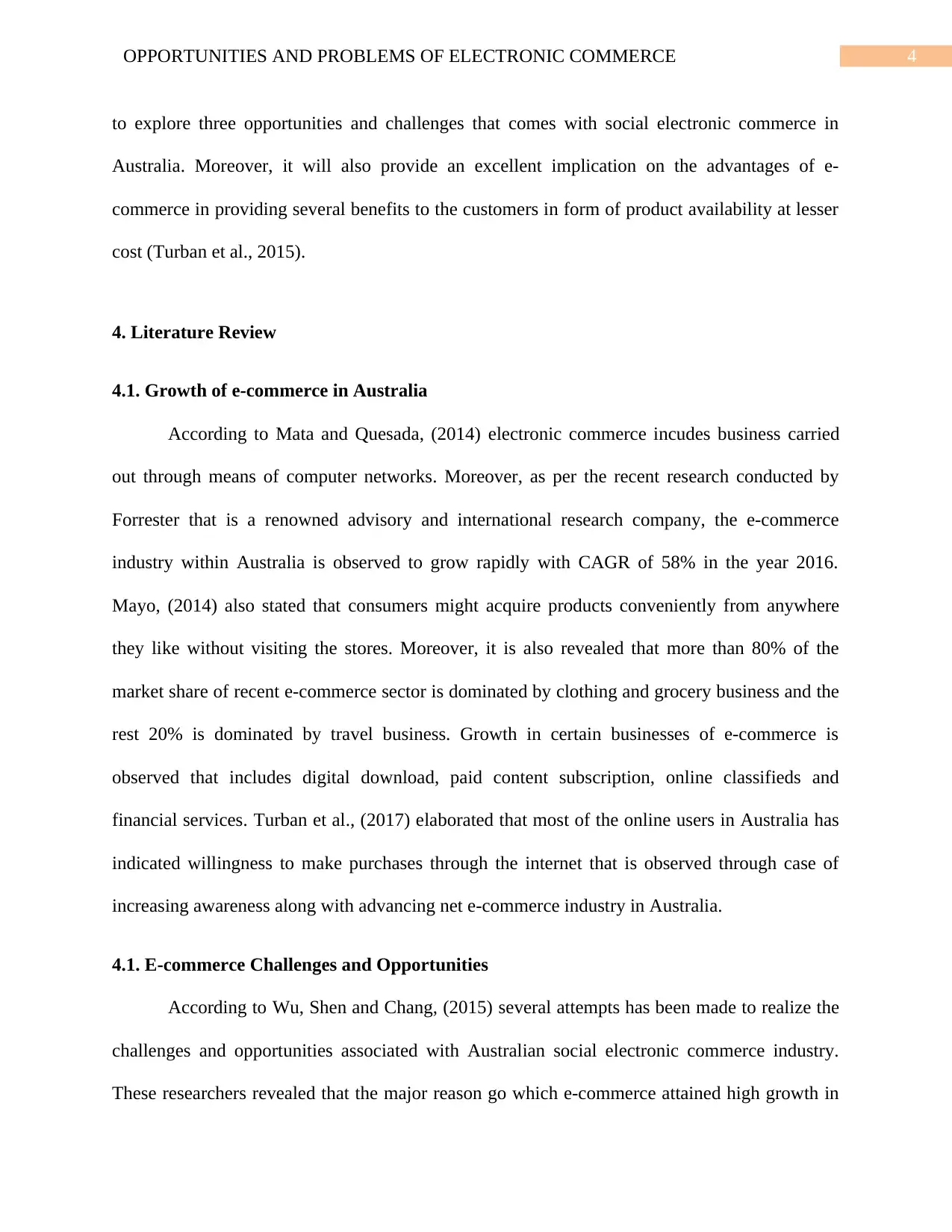
4OPPORTUNITIES AND PROBLEMS OF ELECTRONIC COMMERCE
to explore three opportunities and challenges that comes with social electronic commerce in
Australia. Moreover, it will also provide an excellent implication on the advantages of e-
commerce in providing several benefits to the customers in form of product availability at lesser
cost (Turban et al., 2015).
4. Literature Review
4.1. Growth of e-commerce in Australia
According to Mata and Quesada, (2014) electronic commerce incudes business carried
out through means of computer networks. Moreover, as per the recent research conducted by
Forrester that is a renowned advisory and international research company, the e-commerce
industry within Australia is observed to grow rapidly with CAGR of 58% in the year 2016.
Mayo, (2014) also stated that consumers might acquire products conveniently from anywhere
they like without visiting the stores. Moreover, it is also revealed that more than 80% of the
market share of recent e-commerce sector is dominated by clothing and grocery business and the
rest 20% is dominated by travel business. Growth in certain businesses of e-commerce is
observed that includes digital download, paid content subscription, online classifieds and
financial services. Turban et al., (2017) elaborated that most of the online users in Australia has
indicated willingness to make purchases through the internet that is observed through case of
increasing awareness along with advancing net e-commerce industry in Australia.
4.1. E-commerce Challenges and Opportunities
According to Wu, Shen and Chang, (2015) several attempts has been made to realize the
challenges and opportunities associated with Australian social electronic commerce industry.
These researchers revealed that the major reason go which e-commerce attained high growth in
to explore three opportunities and challenges that comes with social electronic commerce in
Australia. Moreover, it will also provide an excellent implication on the advantages of e-
commerce in providing several benefits to the customers in form of product availability at lesser
cost (Turban et al., 2015).
4. Literature Review
4.1. Growth of e-commerce in Australia
According to Mata and Quesada, (2014) electronic commerce incudes business carried
out through means of computer networks. Moreover, as per the recent research conducted by
Forrester that is a renowned advisory and international research company, the e-commerce
industry within Australia is observed to grow rapidly with CAGR of 58% in the year 2016.
Mayo, (2014) also stated that consumers might acquire products conveniently from anywhere
they like without visiting the stores. Moreover, it is also revealed that more than 80% of the
market share of recent e-commerce sector is dominated by clothing and grocery business and the
rest 20% is dominated by travel business. Growth in certain businesses of e-commerce is
observed that includes digital download, paid content subscription, online classifieds and
financial services. Turban et al., (2017) elaborated that most of the online users in Australia has
indicated willingness to make purchases through the internet that is observed through case of
increasing awareness along with advancing net e-commerce industry in Australia.
4.1. E-commerce Challenges and Opportunities
According to Wu, Shen and Chang, (2015) several attempts has been made to realize the
challenges and opportunities associated with Australian social electronic commerce industry.
These researchers revealed that the major reason go which e-commerce attained high growth in
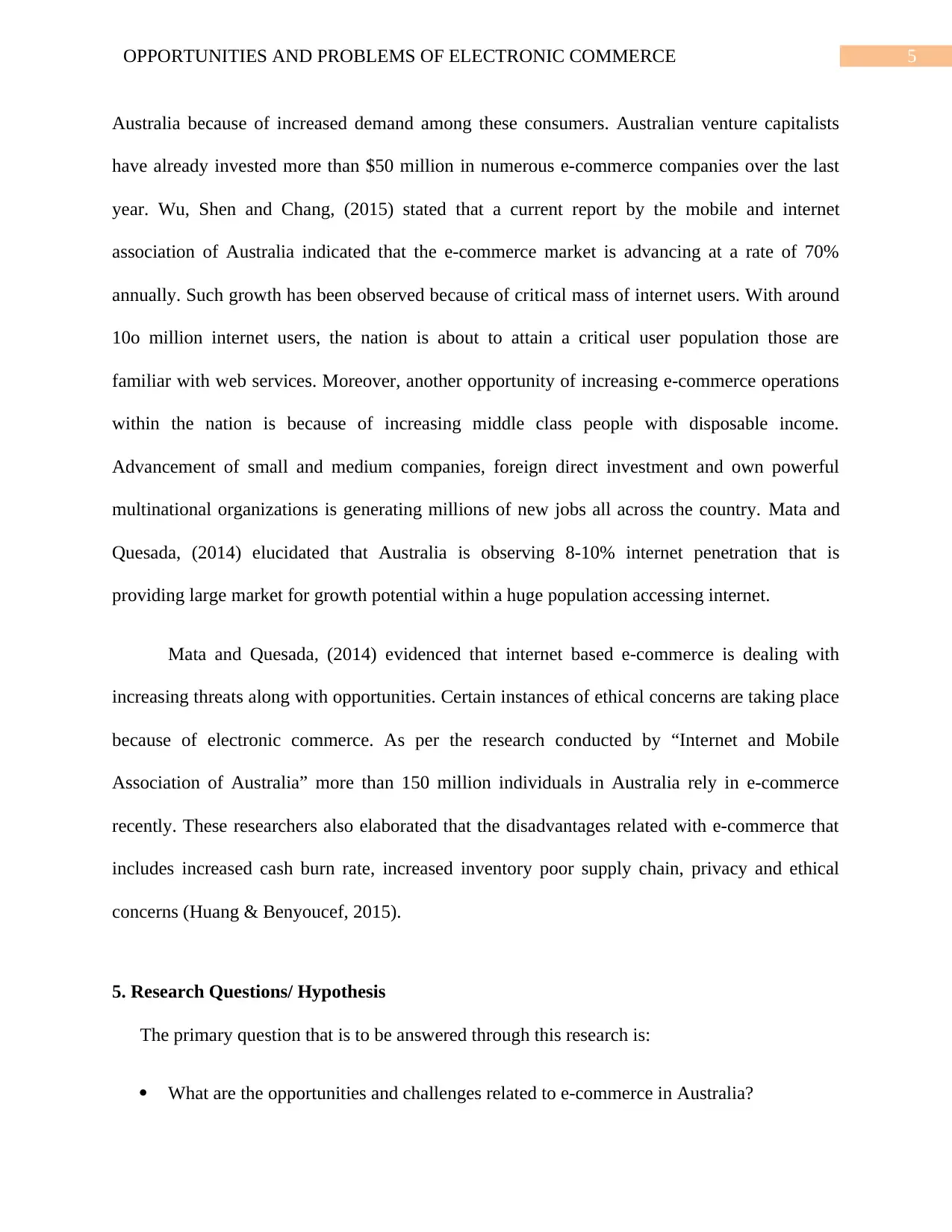
5OPPORTUNITIES AND PROBLEMS OF ELECTRONIC COMMERCE
Australia because of increased demand among these consumers. Australian venture capitalists
have already invested more than $50 million in numerous e-commerce companies over the last
year. Wu, Shen and Chang, (2015) stated that a current report by the mobile and internet
association of Australia indicated that the e-commerce market is advancing at a rate of 70%
annually. Such growth has been observed because of critical mass of internet users. With around
10o million internet users, the nation is about to attain a critical user population those are
familiar with web services. Moreover, another opportunity of increasing e-commerce operations
within the nation is because of increasing middle class people with disposable income.
Advancement of small and medium companies, foreign direct investment and own powerful
multinational organizations is generating millions of new jobs all across the country. Mata and
Quesada, (2014) elucidated that Australia is observing 8-10% internet penetration that is
providing large market for growth potential within a huge population accessing internet.
Mata and Quesada, (2014) evidenced that internet based e-commerce is dealing with
increasing threats along with opportunities. Certain instances of ethical concerns are taking place
because of electronic commerce. As per the research conducted by “Internet and Mobile
Association of Australia” more than 150 million individuals in Australia rely in e-commerce
recently. These researchers also elaborated that the disadvantages related with e-commerce that
includes increased cash burn rate, increased inventory poor supply chain, privacy and ethical
concerns (Huang & Benyoucef, 2015).
5. Research Questions/ Hypothesis
The primary question that is to be answered through this research is:
What are the opportunities and challenges related to e-commerce in Australia?
Australia because of increased demand among these consumers. Australian venture capitalists
have already invested more than $50 million in numerous e-commerce companies over the last
year. Wu, Shen and Chang, (2015) stated that a current report by the mobile and internet
association of Australia indicated that the e-commerce market is advancing at a rate of 70%
annually. Such growth has been observed because of critical mass of internet users. With around
10o million internet users, the nation is about to attain a critical user population those are
familiar with web services. Moreover, another opportunity of increasing e-commerce operations
within the nation is because of increasing middle class people with disposable income.
Advancement of small and medium companies, foreign direct investment and own powerful
multinational organizations is generating millions of new jobs all across the country. Mata and
Quesada, (2014) elucidated that Australia is observing 8-10% internet penetration that is
providing large market for growth potential within a huge population accessing internet.
Mata and Quesada, (2014) evidenced that internet based e-commerce is dealing with
increasing threats along with opportunities. Certain instances of ethical concerns are taking place
because of electronic commerce. As per the research conducted by “Internet and Mobile
Association of Australia” more than 150 million individuals in Australia rely in e-commerce
recently. These researchers also elaborated that the disadvantages related with e-commerce that
includes increased cash burn rate, increased inventory poor supply chain, privacy and ethical
concerns (Huang & Benyoucef, 2015).
5. Research Questions/ Hypothesis
The primary question that is to be answered through this research is:
What are the opportunities and challenges related to e-commerce in Australia?
⊘ This is a preview!⊘
Do you want full access?
Subscribe today to unlock all pages.

Trusted by 1+ million students worldwide
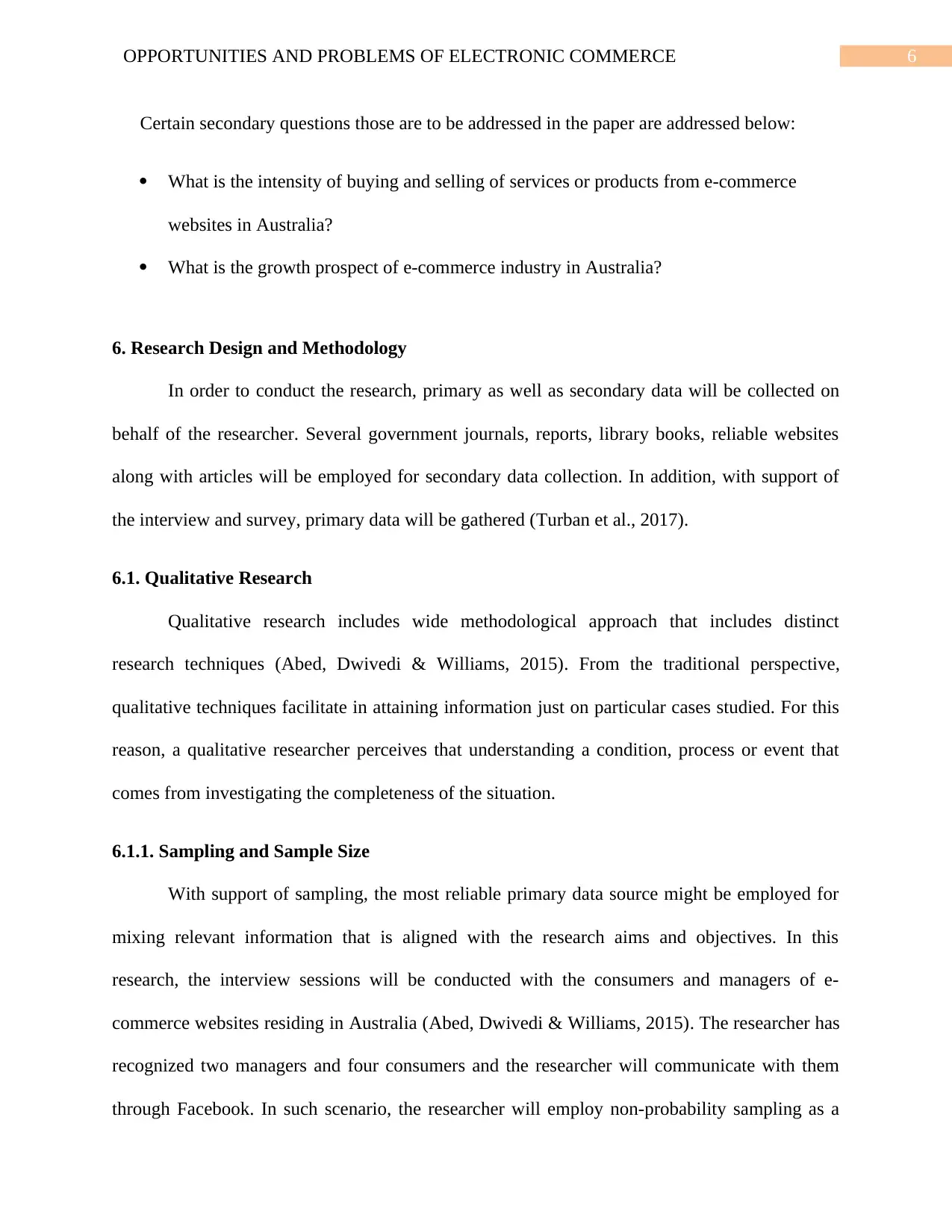
6OPPORTUNITIES AND PROBLEMS OF ELECTRONIC COMMERCE
Certain secondary questions those are to be addressed in the paper are addressed below:
What is the intensity of buying and selling of services or products from e-commerce
websites in Australia?
What is the growth prospect of e-commerce industry in Australia?
6. Research Design and Methodology
In order to conduct the research, primary as well as secondary data will be collected on
behalf of the researcher. Several government journals, reports, library books, reliable websites
along with articles will be employed for secondary data collection. In addition, with support of
the interview and survey, primary data will be gathered (Turban et al., 2017).
6.1. Qualitative Research
Qualitative research includes wide methodological approach that includes distinct
research techniques (Abed, Dwivedi & Williams, 2015). From the traditional perspective,
qualitative techniques facilitate in attaining information just on particular cases studied. For this
reason, a qualitative researcher perceives that understanding a condition, process or event that
comes from investigating the completeness of the situation.
6.1.1. Sampling and Sample Size
With support of sampling, the most reliable primary data source might be employed for
mixing relevant information that is aligned with the research aims and objectives. In this
research, the interview sessions will be conducted with the consumers and managers of e-
commerce websites residing in Australia (Abed, Dwivedi & Williams, 2015). The researcher has
recognized two managers and four consumers and the researcher will communicate with them
through Facebook. In such scenario, the researcher will employ non-probability sampling as a
Certain secondary questions those are to be addressed in the paper are addressed below:
What is the intensity of buying and selling of services or products from e-commerce
websites in Australia?
What is the growth prospect of e-commerce industry in Australia?
6. Research Design and Methodology
In order to conduct the research, primary as well as secondary data will be collected on
behalf of the researcher. Several government journals, reports, library books, reliable websites
along with articles will be employed for secondary data collection. In addition, with support of
the interview and survey, primary data will be gathered (Turban et al., 2017).
6.1. Qualitative Research
Qualitative research includes wide methodological approach that includes distinct
research techniques (Abed, Dwivedi & Williams, 2015). From the traditional perspective,
qualitative techniques facilitate in attaining information just on particular cases studied. For this
reason, a qualitative researcher perceives that understanding a condition, process or event that
comes from investigating the completeness of the situation.
6.1.1. Sampling and Sample Size
With support of sampling, the most reliable primary data source might be employed for
mixing relevant information that is aligned with the research aims and objectives. In this
research, the interview sessions will be conducted with the consumers and managers of e-
commerce websites residing in Australia (Abed, Dwivedi & Williams, 2015). The researcher has
recognized two managers and four consumers and the researcher will communicate with them
through Facebook. In such scenario, the researcher will employ non-probability sampling as a
Paraphrase This Document
Need a fresh take? Get an instant paraphrase of this document with our AI Paraphraser
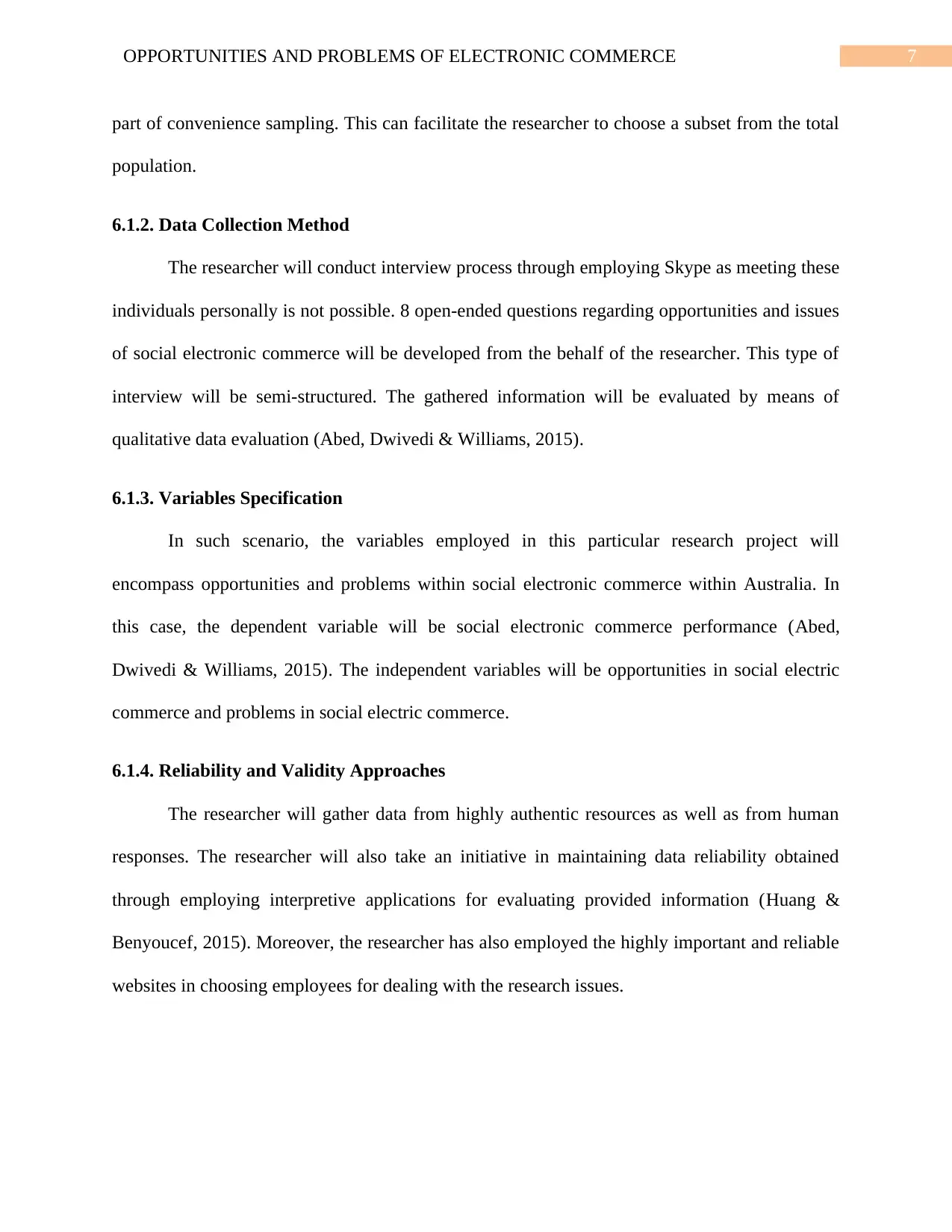
7OPPORTUNITIES AND PROBLEMS OF ELECTRONIC COMMERCE
part of convenience sampling. This can facilitate the researcher to choose a subset from the total
population.
6.1.2. Data Collection Method
The researcher will conduct interview process through employing Skype as meeting these
individuals personally is not possible. 8 open-ended questions regarding opportunities and issues
of social electronic commerce will be developed from the behalf of the researcher. This type of
interview will be semi-structured. The gathered information will be evaluated by means of
qualitative data evaluation (Abed, Dwivedi & Williams, 2015).
6.1.3. Variables Specification
In such scenario, the variables employed in this particular research project will
encompass opportunities and problems within social electronic commerce within Australia. In
this case, the dependent variable will be social electronic commerce performance (Abed,
Dwivedi & Williams, 2015). The independent variables will be opportunities in social electric
commerce and problems in social electric commerce.
6.1.4. Reliability and Validity Approaches
The researcher will gather data from highly authentic resources as well as from human
responses. The researcher will also take an initiative in maintaining data reliability obtained
through employing interpretive applications for evaluating provided information (Huang &
Benyoucef, 2015). Moreover, the researcher has also employed the highly important and reliable
websites in choosing employees for dealing with the research issues.
part of convenience sampling. This can facilitate the researcher to choose a subset from the total
population.
6.1.2. Data Collection Method
The researcher will conduct interview process through employing Skype as meeting these
individuals personally is not possible. 8 open-ended questions regarding opportunities and issues
of social electronic commerce will be developed from the behalf of the researcher. This type of
interview will be semi-structured. The gathered information will be evaluated by means of
qualitative data evaluation (Abed, Dwivedi & Williams, 2015).
6.1.3. Variables Specification
In such scenario, the variables employed in this particular research project will
encompass opportunities and problems within social electronic commerce within Australia. In
this case, the dependent variable will be social electronic commerce performance (Abed,
Dwivedi & Williams, 2015). The independent variables will be opportunities in social electric
commerce and problems in social electric commerce.
6.1.4. Reliability and Validity Approaches
The researcher will gather data from highly authentic resources as well as from human
responses. The researcher will also take an initiative in maintaining data reliability obtained
through employing interpretive applications for evaluating provided information (Huang &
Benyoucef, 2015). Moreover, the researcher has also employed the highly important and reliable
websites in choosing employees for dealing with the research issues.
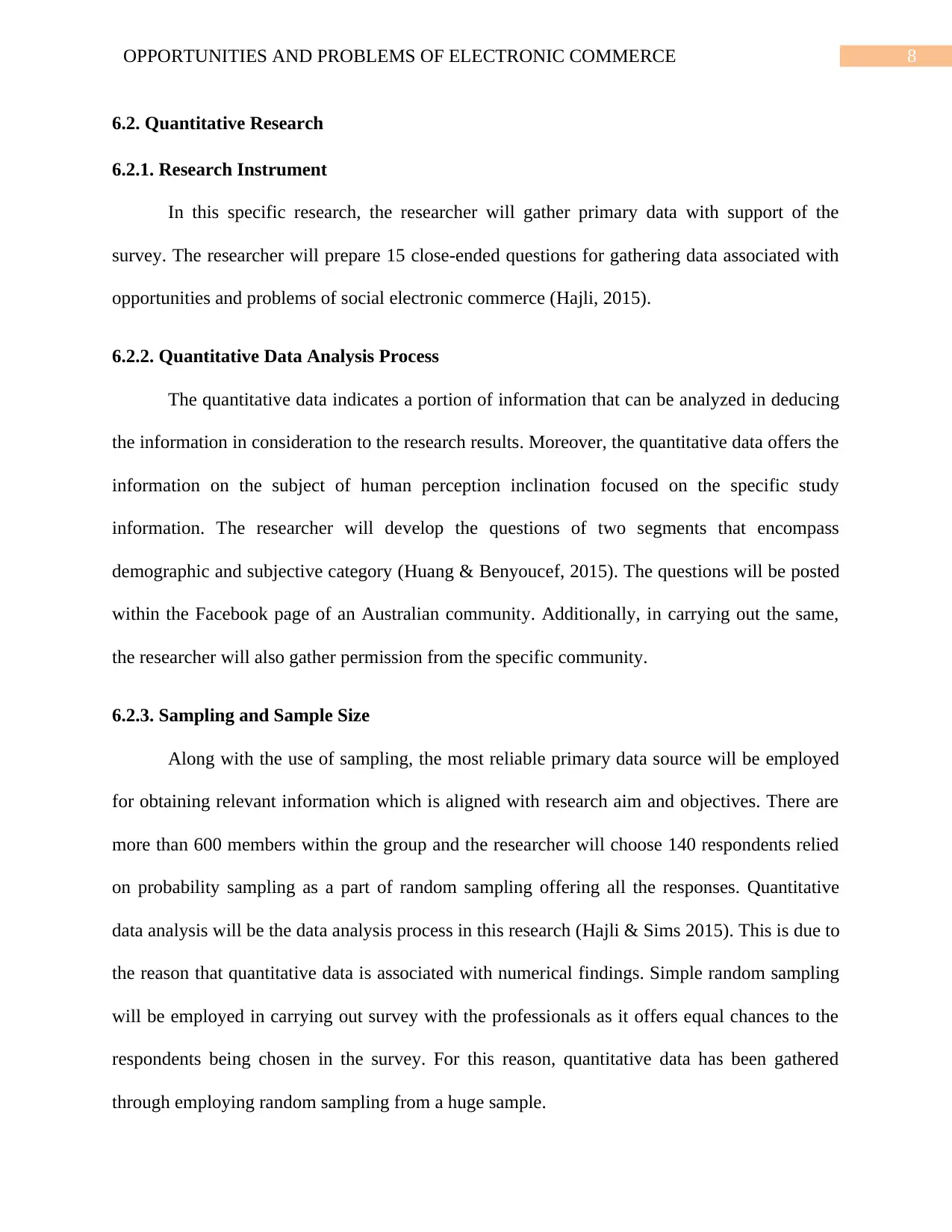
8OPPORTUNITIES AND PROBLEMS OF ELECTRONIC COMMERCE
6.2. Quantitative Research
6.2.1. Research Instrument
In this specific research, the researcher will gather primary data with support of the
survey. The researcher will prepare 15 close-ended questions for gathering data associated with
opportunities and problems of social electronic commerce (Hajli, 2015).
6.2.2. Quantitative Data Analysis Process
The quantitative data indicates a portion of information that can be analyzed in deducing
the information in consideration to the research results. Moreover, the quantitative data offers the
information on the subject of human perception inclination focused on the specific study
information. The researcher will develop the questions of two segments that encompass
demographic and subjective category (Huang & Benyoucef, 2015). The questions will be posted
within the Facebook page of an Australian community. Additionally, in carrying out the same,
the researcher will also gather permission from the specific community.
6.2.3. Sampling and Sample Size
Along with the use of sampling, the most reliable primary data source will be employed
for obtaining relevant information which is aligned with research aim and objectives. There are
more than 600 members within the group and the researcher will choose 140 respondents relied
on probability sampling as a part of random sampling offering all the responses. Quantitative
data analysis will be the data analysis process in this research (Hajli & Sims 2015). This is due to
the reason that quantitative data is associated with numerical findings. Simple random sampling
will be employed in carrying out survey with the professionals as it offers equal chances to the
respondents being chosen in the survey. For this reason, quantitative data has been gathered
through employing random sampling from a huge sample.
6.2. Quantitative Research
6.2.1. Research Instrument
In this specific research, the researcher will gather primary data with support of the
survey. The researcher will prepare 15 close-ended questions for gathering data associated with
opportunities and problems of social electronic commerce (Hajli, 2015).
6.2.2. Quantitative Data Analysis Process
The quantitative data indicates a portion of information that can be analyzed in deducing
the information in consideration to the research results. Moreover, the quantitative data offers the
information on the subject of human perception inclination focused on the specific study
information. The researcher will develop the questions of two segments that encompass
demographic and subjective category (Huang & Benyoucef, 2015). The questions will be posted
within the Facebook page of an Australian community. Additionally, in carrying out the same,
the researcher will also gather permission from the specific community.
6.2.3. Sampling and Sample Size
Along with the use of sampling, the most reliable primary data source will be employed
for obtaining relevant information which is aligned with research aim and objectives. There are
more than 600 members within the group and the researcher will choose 140 respondents relied
on probability sampling as a part of random sampling offering all the responses. Quantitative
data analysis will be the data analysis process in this research (Hajli & Sims 2015). This is due to
the reason that quantitative data is associated with numerical findings. Simple random sampling
will be employed in carrying out survey with the professionals as it offers equal chances to the
respondents being chosen in the survey. For this reason, quantitative data has been gathered
through employing random sampling from a huge sample.
⊘ This is a preview!⊘
Do you want full access?
Subscribe today to unlock all pages.

Trusted by 1+ million students worldwide
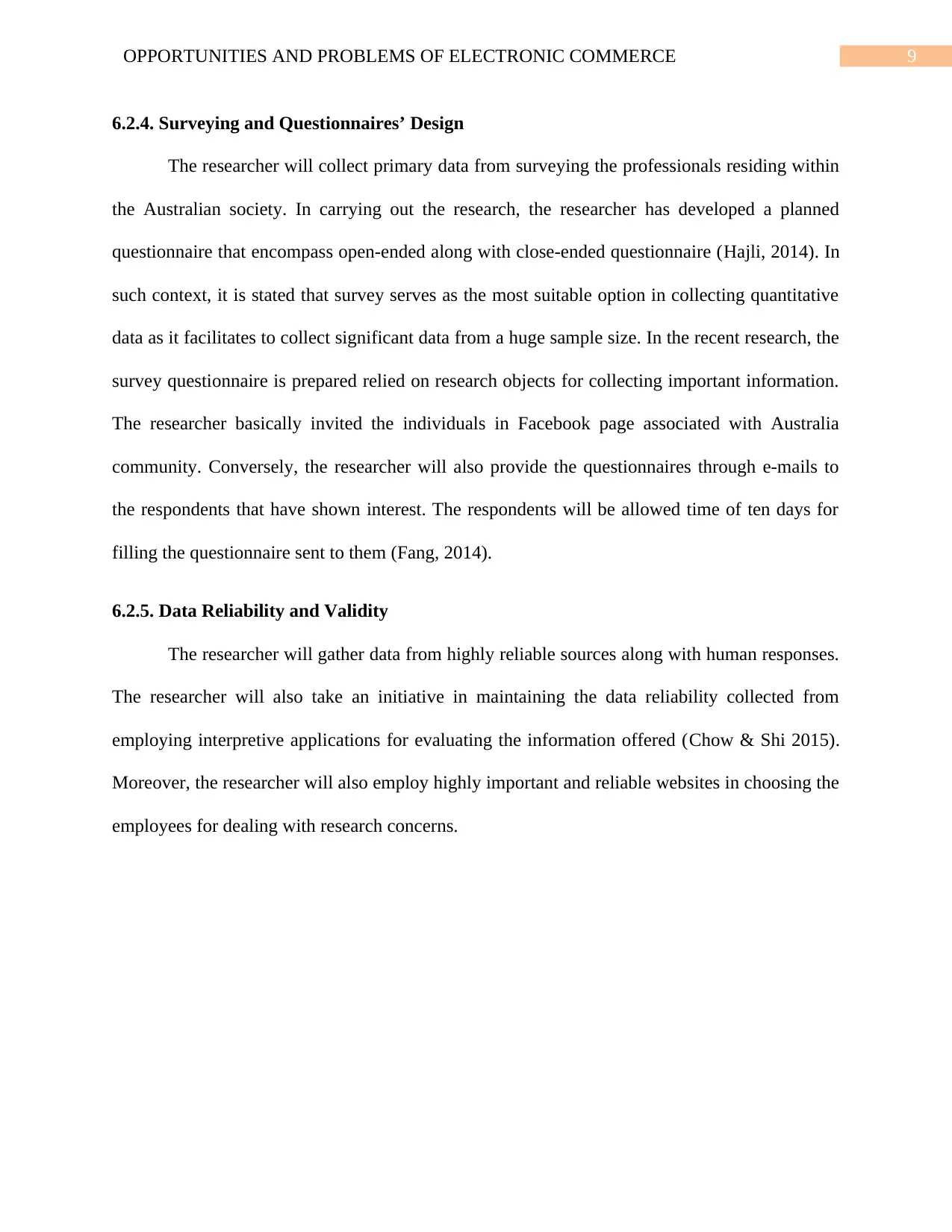
9OPPORTUNITIES AND PROBLEMS OF ELECTRONIC COMMERCE
6.2.4. Surveying and Questionnaires’ Design
The researcher will collect primary data from surveying the professionals residing within
the Australian society. In carrying out the research, the researcher has developed a planned
questionnaire that encompass open-ended along with close-ended questionnaire (Hajli, 2014). In
such context, it is stated that survey serves as the most suitable option in collecting quantitative
data as it facilitates to collect significant data from a huge sample size. In the recent research, the
survey questionnaire is prepared relied on research objects for collecting important information.
The researcher basically invited the individuals in Facebook page associated with Australia
community. Conversely, the researcher will also provide the questionnaires through e-mails to
the respondents that have shown interest. The respondents will be allowed time of ten days for
filling the questionnaire sent to them (Fang, 2014).
6.2.5. Data Reliability and Validity
The researcher will gather data from highly reliable sources along with human responses.
The researcher will also take an initiative in maintaining the data reliability collected from
employing interpretive applications for evaluating the information offered (Chow & Shi 2015).
Moreover, the researcher will also employ highly important and reliable websites in choosing the
employees for dealing with research concerns.
6.2.4. Surveying and Questionnaires’ Design
The researcher will collect primary data from surveying the professionals residing within
the Australian society. In carrying out the research, the researcher has developed a planned
questionnaire that encompass open-ended along with close-ended questionnaire (Hajli, 2014). In
such context, it is stated that survey serves as the most suitable option in collecting quantitative
data as it facilitates to collect significant data from a huge sample size. In the recent research, the
survey questionnaire is prepared relied on research objects for collecting important information.
The researcher basically invited the individuals in Facebook page associated with Australia
community. Conversely, the researcher will also provide the questionnaires through e-mails to
the respondents that have shown interest. The respondents will be allowed time of ten days for
filling the questionnaire sent to them (Fang, 2014).
6.2.5. Data Reliability and Validity
The researcher will gather data from highly reliable sources along with human responses.
The researcher will also take an initiative in maintaining the data reliability collected from
employing interpretive applications for evaluating the information offered (Chow & Shi 2015).
Moreover, the researcher will also employ highly important and reliable websites in choosing the
employees for dealing with research concerns.
Paraphrase This Document
Need a fresh take? Get an instant paraphrase of this document with our AI Paraphraser
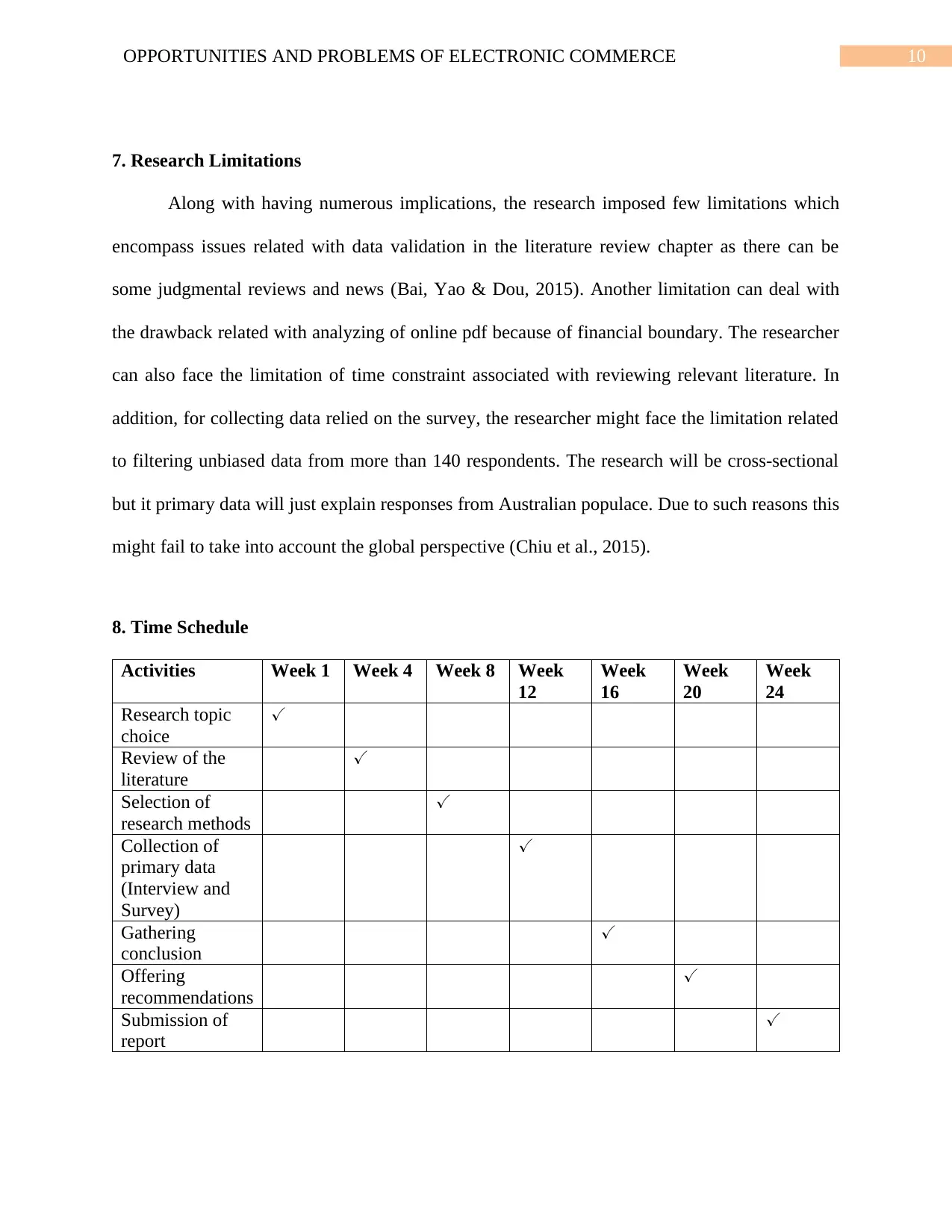
10OPPORTUNITIES AND PROBLEMS OF ELECTRONIC COMMERCE
7. Research Limitations
Along with having numerous implications, the research imposed few limitations which
encompass issues related with data validation in the literature review chapter as there can be
some judgmental reviews and news (Bai, Yao & Dou, 2015). Another limitation can deal with
the drawback related with analyzing of online pdf because of financial boundary. The researcher
can also face the limitation of time constraint associated with reviewing relevant literature. In
addition, for collecting data relied on the survey, the researcher might face the limitation related
to filtering unbiased data from more than 140 respondents. The research will be cross-sectional
but it primary data will just explain responses from Australian populace. Due to such reasons this
might fail to take into account the global perspective (Chiu et al., 2015).
8. Time Schedule
Activities Week 1 Week 4 Week 8 Week
12
Week
16
Week
20
Week
24
Research topic
choice
✓
Review of the
literature
✓
Selection of
research methods
✓
Collection of
primary data
(Interview and
Survey)
✓
Gathering
conclusion
✓
Offering
recommendations
✓
Submission of
report
✓
7. Research Limitations
Along with having numerous implications, the research imposed few limitations which
encompass issues related with data validation in the literature review chapter as there can be
some judgmental reviews and news (Bai, Yao & Dou, 2015). Another limitation can deal with
the drawback related with analyzing of online pdf because of financial boundary. The researcher
can also face the limitation of time constraint associated with reviewing relevant literature. In
addition, for collecting data relied on the survey, the researcher might face the limitation related
to filtering unbiased data from more than 140 respondents. The research will be cross-sectional
but it primary data will just explain responses from Australian populace. Due to such reasons this
might fail to take into account the global perspective (Chiu et al., 2015).
8. Time Schedule
Activities Week 1 Week 4 Week 8 Week
12
Week
16
Week
20
Week
24
Research topic
choice
✓
Review of the
literature
✓
Selection of
research methods
✓
Collection of
primary data
(Interview and
Survey)
✓
Gathering
conclusion
✓
Offering
recommendations
✓
Submission of
report
✓
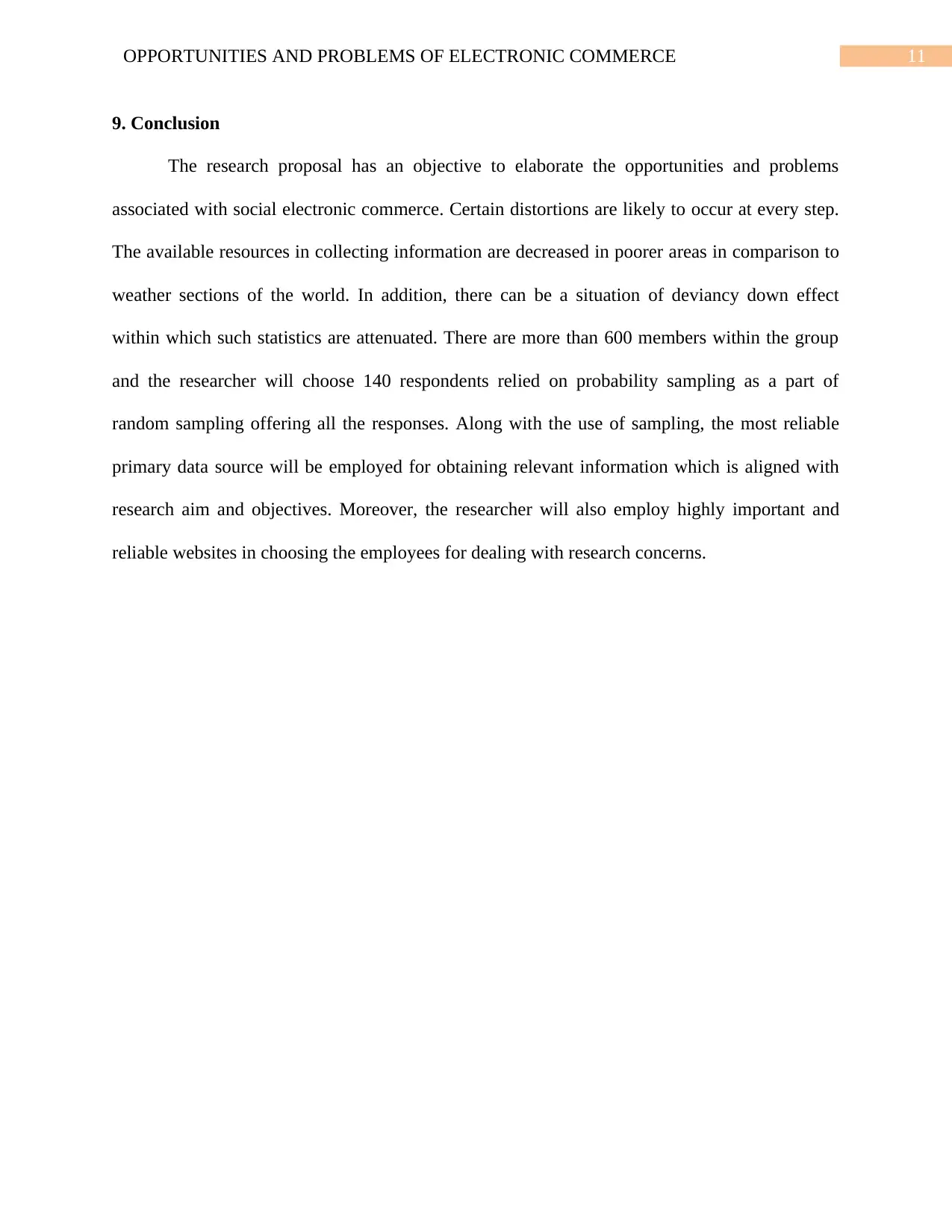
11OPPORTUNITIES AND PROBLEMS OF ELECTRONIC COMMERCE
9. Conclusion
The research proposal has an objective to elaborate the opportunities and problems
associated with social electronic commerce. Certain distortions are likely to occur at every step.
The available resources in collecting information are decreased in poorer areas in comparison to
weather sections of the world. In addition, there can be a situation of deviancy down effect
within which such statistics are attenuated. There are more than 600 members within the group
and the researcher will choose 140 respondents relied on probability sampling as a part of
random sampling offering all the responses. Along with the use of sampling, the most reliable
primary data source will be employed for obtaining relevant information which is aligned with
research aim and objectives. Moreover, the researcher will also employ highly important and
reliable websites in choosing the employees for dealing with research concerns.
9. Conclusion
The research proposal has an objective to elaborate the opportunities and problems
associated with social electronic commerce. Certain distortions are likely to occur at every step.
The available resources in collecting information are decreased in poorer areas in comparison to
weather sections of the world. In addition, there can be a situation of deviancy down effect
within which such statistics are attenuated. There are more than 600 members within the group
and the researcher will choose 140 respondents relied on probability sampling as a part of
random sampling offering all the responses. Along with the use of sampling, the most reliable
primary data source will be employed for obtaining relevant information which is aligned with
research aim and objectives. Moreover, the researcher will also employ highly important and
reliable websites in choosing the employees for dealing with research concerns.
⊘ This is a preview!⊘
Do you want full access?
Subscribe today to unlock all pages.

Trusted by 1+ million students worldwide
1 out of 14
Related Documents
Your All-in-One AI-Powered Toolkit for Academic Success.
+13062052269
info@desklib.com
Available 24*7 on WhatsApp / Email
![[object Object]](/_next/static/media/star-bottom.7253800d.svg)
Unlock your academic potential
Copyright © 2020–2025 A2Z Services. All Rights Reserved. Developed and managed by ZUCOL.





